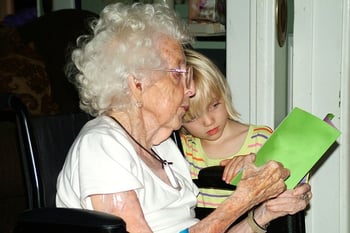It usually begins at about the second week of December: articles and blog posts proclaim and predict the future of the following year. In the senior living field, there is no shortage of such prognostications, and I am happy to have devoured them. Many are well thought out and useful. So, similar to what we did two years ago in this space, I have examined the predictions of others and offered here my review of them.
To begin, it’s worth mentioning as an overarching theme for the coming decade a December 27 Forbes article by William Haseltine, chair and president of ACCESS Health International. He highlights the World Health Organization’s proclamation that the 2020s will be “the Decade of Healthy Ageing,” and asserts that health systems around the world “are woefully underequipped to provide the care that healthy aging requires” and that over the next 10 years, “the pressure will be on for national governments, policymakers, and healthcare providers to redress the scarcity of resources available to the elderly and the people who care for them.”

In addition, Haseltine says that long-term care systems around the world need to be bolstered by research, development, and funding and suggests that for such care “to be accessible, affordable, and equitable to all, they must discard a notion of health overdetermined by illness and treatment in favor of one befitting the full complexity of the person.” In other words, person-centered care should be paramount in long-term care. While not a new suggestion, he is correct. In my opinion, these assertions provide an excellent backdrop for the following overviews:
1. Disruption: Not to overuse a nearly worn-out term but disruption is still a thing, and it’s going to be a thing in senior living until providers catch up with the rest of the world when it comes to inn
ovation and technology. That said, let this paragraph from the Senior Housing News predictor article sink in: “Tech behemoths such as Amazon and Apple have been making moves into the senior health care space and could eventually disrupt senior living—as several industry leaders have warned. And last year, Reddit co-founder Alexis Ohanian—who now runs a venture capital firm—predicted a decade of ‘major change’ is on the way for senior living, and he foresees the rise of a disruptive, tech-forward senior brand.”
In other words, the article states, “in 2020, the disruption threat level will rise.” In my opinion, this news is a long time coming. I see two options for providers and those who serve them: we (as an industry) can wait for the Amazons and Apples to find their blue ocean in our red sea or we can get busy with our own disruption and make something really cool happen.
2. Machine Learning: The abundance of healthcare data available via government records, health care professionals, pharmacies, insurance companies, and others is being used to predict health issues and prescribe medication or lifestyle changes. Adding to this mix, the access to behavioral data of older adults will lead to “improved prediction and accuracy and better services for older adults,” in 2020, according to Senior Living News. This, the writers state, will eventually result in improving the lives of older adults.
3. The Emergence of WiFi Doppler Imaging: Another interesting prediction in from Senior Living News is the idea that WiFi Doppler imaging will bring “new possibilities” to PERS and fall detectio
n devices by deploying a WiFi signal to “generate imaging data that can be interpreted into insights about the movements of people and objects within a given environment.” According to the writers, since academia and industry are working to make fall detection less intrusive, the WiFI Doppler technology has a greater chance of success over the next year or two.
4. Workforce: What would a prediction in senior living be without mentioning workforce? It’s an ever-present topic of course. Here are some good workforce-related 2020 forecasts:
- McKnight’s Editorial Director John O’Connor predicts that the call for staffing quotas will not go away. “Never mind that finding and keeping workers is arguably the biggest challenge the industry faces. It’s election season,” he says. You can’t really argue with that one especially, as he says, “candidates at every point will be demanding staffing quotas.”
- Skilled Nursing News published a smart list of predictions based on interviews with senior living executives. Among them is a trend noted among larger operators. “We are receiving a large volume of calls from various SNF operators who are very interested in converting their contract therapy to an in-house model,” said the president of a therapy company. The reason behind this, according to the executive, is two-fold: first, the “SNF operators are realizing therapy is now a cost center and they want to take control of their own expenses.” The second reason is due to an apparent flood of therapists in the labor market.
5. PDPM: As the now ubiquitous new SNF payment model sinks in, “smaller nursing home chains in rural areas that have put their heads in the sand amid the PDPM shift will find ‘reimbursement repercussions to be pretty significant,’” according to Fred Bentley, managing director of consulting firm Avalere Health. He says that although the skilled nursing space won’t fully feel the results of PDPM until 2020, “in some instances, it does mean scaling back on therapy—but not maybe as much as the industry had supposed.”
In another Skilled Nursing News article on 2020 trends, the author states this about PDPM: “if there’s one truism in covering an industry that overwhelmingly relies on government agencies to exist, it’s that operators will quickly adapt to whatever new rules that officials implement in an attempt to control their behavior.” The article cites the example of the industry’s adaptation under the Resource Utilization Group system as proof and adds that “early returns are demonstrating that there are far more reimbursement winners than losers, even when accounting a quirk of the transition process that saw most every operator receive a non-repeated boost for certain residents.”
Whatever happens in 2020, it is sure to be a year of transition, especially in light of PDPM, as well as the inevitable disruption that comes when significant corporate players realize the vastness and value of the longevity economy.
 Generations United and LeadingAge that distills the results of a year-long study on the nature and extent of intergeneration programming in senior housing.
Generations United and LeadingAge that distills the results of a year-long study on the nature and extent of intergeneration programming in senior housing.
 reminder that post-acute care stands on the precipice of major change. In fact, the opening line of the report alludes to this conclusion: “A&M believes the post-acute sector will be transformed during the next 10 years.”
reminder that post-acute care stands on the precipice of major change. In fact, the opening line of the report alludes to this conclusion: “A&M believes the post-acute sector will be transformed during the next 10 years.”